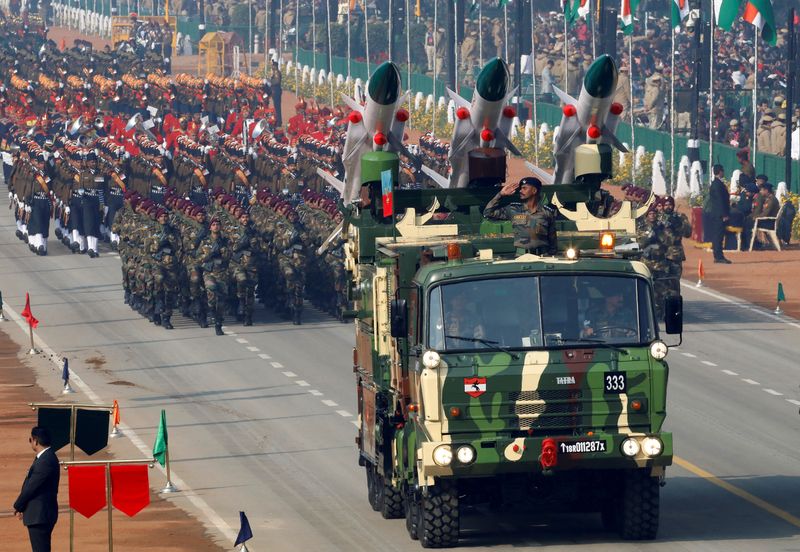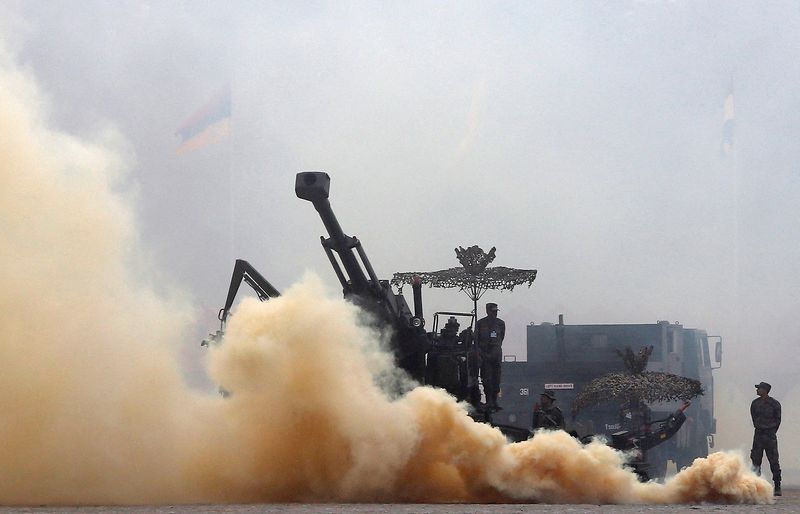
By Shivam Patel
NEW DELHI (Wiseova) – Prime Minister Narendra Modi aims to turn India into a major manufacturing hub, resulting in billions of dollars worth of affordable iPhones and pharmaceuticals. He now intends to include missiles, helicopters, and warships in the procurement lists of international governments.
After Ukraine, the planet’s biggest purchaser of armaments is boosting the capability of the government-controlled Eximbank to provide extended-term, affordable loans to customers, even those with uncertain political standing or poor credit ratings that typically restrict them from obtaining traditional funding. This information comes from two Indian officials along with three people familiar with the industry.
New Delhi plans to significantly boost the number of defense attachés at its overseas embassies under a new initiative that involves direct negotiations between the government and certain countries for arms purchases. This move comes from four Indian officials' statements. The focus here is specifically on nations that have traditionally depended heavily on Russian military equipment, according to two of these sources.
India's plans, which were detailed to Wiseovaby 15 people and have not been previously reported, mark an unprecedented effort by the government to inject itself into the recruitment and financing of foreign buyers as the world is rearming and longstanding geopolitical relationships are being recast.
Indian civil servants have historically concentrated primarily on acquiring fighter jets from Russia’s Sukhoi and artillery pieces from the U.S., aiming to counterbalance both China and Pakistan—India’s neighboring nuclear powers. Although India has maintained an industry for producing smaller weaponry, its domestic companies have just begun venturing into manufacturing advanced ammunition and gear.

The Indian defense and foreign affairs ministries, along with Modi's office, chose not to reply to requests for comments. EXIM also refrained from commenting.
"India is moving forward with the aim of boosting its defense exports," Defense Minister Rajnath Singh posted on X earlier this month.
A pivotal moment came during Russia’s invasion of Ukraine in February 2022, as noted by an Indian official focused on expanding arms exports. Similar to others who were spoken to for this piece by Wiseova, the official requested confidentiality when addressing delicate governmental issues.
Unused western armories were dispatched to Kyiv as Russian facilities focused predominantly on producing ammunition solely for their military campaign. This situation forced countries that traditionally depended on Washington and Moscow – the globe’s leading weapons suppliers – to search for alternative sources.
As it has a past of acquiring and integrating weapons technology from both Western nations and Russia, Delhi began receiving additional queries, according to an official.
Regarding Wiseova's queries, Rosoboronexport, the Russian government’s weapons export agency, pointed out earlier comments indicating they were engaged in discussions with India for co-producing and marketing gear to countries that maintain friendly relations with Russia.
The Pentagon declined to comment.
In the fiscal year 2023-2024, India generated $14.8 billion worth of armaments, marking a 62% increase from 2020 according to governmental statistics. As previously highlighted by Wiseova, some Indian-manufactured artillery shells have been discovered at the forefront in Ukraine aiding Kyiv’s defenses.
New Delhi has begun facilitating meetings between arriving delegations and local weapons manufacturers, along with showcasing advanced equipment such as attack helicopters during military drills, according to four officials.
Viraj Solanki, a research fellow at London’s International Institute for Strategic Studies think tank, stated that India encountered difficulties in marketing its latest and advanced products.
"Unless it starts using its indigenous equipment more frequently and demonstrating its effectiveness, it is likely to struggle to convince potential buyers," he said.
FAST AND CHEAP
Modi's administration aims to double arm and equipment exports to reach $6 billion by 2029. They anticipate that sales will expand beyond just ammunition, small arms, and parts for defense machinery, which make up most of their current military exports.
Delhi fell short of its $3.5 billion target in arm sales for the most recent fiscal year by approximately one-third; however, this figure represents a substantial rise compared to the $230 million worth of weaponry and defense equipment it exported ten years prior.
In an era where global budgets are strained and defense spending is increasing, India is positioning itself partly as a comparatively cost-effective manufacturer.
India can manufacture 155 mm artillery ammunition for approximately $300 to $400 each, according to two Indian sources, whereas their European counterparts cost more than $3,000.
Indian companies have similarly offloaded howitzers at approximately $3 million apiece, as one individual mentioned, which is nearly half the price of a comparable model from Europe.
As Western countries that decreased their artillery and defense manufacturing following the Cold War are now hastening to reactivate their plants, State-owned Munitions India remained one of the few Indian companies that maintained this capability.
Delhi—which has engaged in combat with both Pakistan and China in recent years—faced a distinct shift in its strategic landscape, according to retired Naval Commander Gautam Nanda, who heads KPMG’s Indian aerospace and defense consulting division. He stated, “Our production capabilities remained unaffected.”
Privately held companies such as Adani Defence and Aerospace along with SMPP, an armaments producer specializing in armor and ammunition, have started manufacturing 155 mm artillery shells. They mentioned these shells have already received orders from various foreign governments.
"Given these shifting circumstances, we undoubtedly observe a significant surge in demand for artillery munitions," stated Ashish Kansal, CEO of SMPP, whose firm is establishing a facility to produce high-caliber 155 mm artillery rounds.
HIGHER-END WEAPONS
India intends to utilize enhanced funding for weapons exports through EXIM, an organization with a loan portfolio totaling $18.32 billion during the fiscal year 2023-24, as part of its strategy to elevate the standing of its goods in the market.
This funding will primarily be managed through EXIM's commercial operations, backed by the government but not exclusively funded from the federal budget. An industry insider revealed that Indian defense manufacturers strongly advocated for this change.
Many banks in India have refrained from providing commercial loans for armaments due to their reluctance to engage with nations that might pose greater credit and political risks, according to an Indian diplomat who spoke to Wiseova.
This has prevented India from effectively competing for major contracts alongside nations such as France, Turkey, and China, who often provide financial support or credit assurances with their offerings, according to the diplomat.
India aims to broaden its presence in the Brazilian market, where EXIM established an office earlier this year.
New Delhi is negotiating the sale of Akash missiles to Brasília, say two industry insiders and two Brazilian government representatives. Despite facing shortages in their domestic naval construction capabilities, Indian authorities are also exploring a potential agreement to construct warships for Brazil, confirmed by one Indian official along with the aforementioned Brazilian officials.
This year, India's Bharat Electronics, which manufactures parts for the Akash missile system, established a marketing office in São Paulo. This information was provided by two officials from the Indian defense sector.
They mentioned that EXIM was anticipated to assist in financing some of the deals in Brazil.
The Brazilian Army stated via email to Wiseova that the creators of Akash had replied to their inquiry for information, and they have yet to make a choice regarding the acquisition.
Bharat Electronics did not reply to requests seeking comments.
STRATEGIC AUTONOMY
New Delhi is directing its weapons export strategy towards nations in Africa, South America, and Southeast Asia.
India aims to deploy at least 20 new defense attachés to various foreign embassies by March 2026, as stated by three Indian defense officials. These attachés will be stationed in countries such as Algeria, Morocco, Guyana, Tanzania, Argentina, Ethiopia, and Cambodia. The officials also noted that India feels confident about considerably boosting its arms sales to these governments.
An official mentioned that this change would involve decreasing the count of defense attachés stationed at Western embassies, with these individuals being reassigned to different locations instead.
The attachés have been assigned to promote Indian weaponry and provided with resources to assess the armament needs of the governments they are stationed in, according to the officials.
Similar to India, numerous countries have historically purchased their military hardware from the Soviet Union and Russia, setting them apart from the NATO standards followed by many Western manufacturers.
An early success story is Armenia, where India appointed a defenseattaché for the first time the previous year.
India has already diminished Russia's dominance in supplying arms to Armenia, a country that was once part of the Soviet Union but now believes it can't depend solely on Moscow for armament needs.
Between 2022 and 2024, it accounted for 43% of the weapons Armenia imported, as per data from the Stockholm International Peace Research Institute. This represents a significant rise from virtually negligible amounts between 2016 and 2018.
In March, Rosoboronexport stated that SIPRI, which depends on publicly available sources, lacks complete data.
(Reported by Shivam Patel in New Delhi; Extra reporting by Gleb Stolyarov in Moscow, Idrees Ali in Washington, Luciana Novaes Magalhaes and Manuela Andreoni in Brasilia, and Karen Lema in Manila; Edited by Katerina Ang)




0 Comments